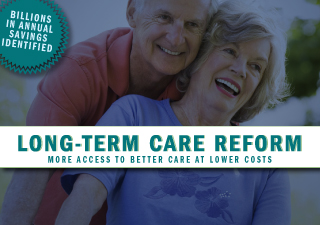Report

Long-Term Care Reform
Executive Summary
Long-term care is very expensive whether provided in a nursing home, an assisted living facility, or in someone’s home. Medicaid pays for most professional long-term care (LTC) in Pennsylvania. LTC currently costs Pennsylvania taxpayers $6.6 billion per year, making up 40% of all Medicaid spending (much higher than the national average). Because of the commonwealth’s aging population, taxpayer costs for Medicaid long-term care will skyrocket in the coming years absent reform.
Most people prefer to receive LTC in their homes instead of a nursing home, but in Pennsylvania, Medicaid pays primarily for nursing home care. That balance will soon change as the state pursues a massive “rebalancing” of Medicaid, which one state official compared to the “Manhattan Project.” The goal is to provide more home care at a lower cost, based on the idea that home care is less expensive than nursing home care.
But research shows that home care does not result in overall savings. Providing more home care delays, but does not replace, institutional care, and actually costs more in the long run. Furthermore, rebalancing without addressing broad eligibility issues discourages family-provided care and private LTC financing alternatives, while encouraging more costly Medicaid enrollment and “Medicaid Planning,” or artificial impoverishment.
Because Medicaid will be unable to fund quality care adequately for a rapidly growing frail or infirm elderly population, Pennsylvania must reduce Medicaid LTC costs without sacrificing medically appropriate services to all qualified recipients.
The only way to reform Medicaid LTC, and provide more home care while saving money, is to reduce the number of Pennsylvanians who become dependent on the program in the future. Four alternative sources of LTC financing exist: (1) Asset Spend Down, (2) Estate Recoveries, (3) Home Equity Conversion, and (4) Private Long-Term Care Insurance.
- Asset Spend Down: Most people assume Medicaid eligibility rules impose draconian income and asset limits that require applicants to spend down catastrophically into impoverishment. In fact, Medicaid long-term care eligibility rules are far more generous and asset spend down is an underutilized source of LTC financing. The key is to reach aging Pennsylvanians while they are still young, healthy, and affluent enough and persuade them to plan responsibly for LTC so they never become “dual eligibles” for both Medicare and Medicaid. Pennsylvania would save nearly $120 million per year by preventing only 20% of its dual eligibles from ending up dependent on the program in the future.
- Estate Recoveries: If Pennsylvania Medicaid recovered funds from estates at the same rate as Oregon, the commonwealth could recover an additional $213 million per year.
- Home Equity Conversion: Pennsylvania may have 135,000 households “at risk for spending down,” that could receive an estimated $62,800, each or $8.5 billion in total from reverse mortgages to help pay for their own long-term care, and stay off Medicaid or at least delay Medicaid dependency.
- Private Long-Term Care Insurance: In the absence of Medicaid’s $500,000 home equity exemption, and with tougher income and asset limits, far more Pennsylvanians would purchase private long-term care insurance, avoid Medicaid dependency altogether, and save the commonwealth hundreds of millions of dollars each year.
This report explains how these alternative funding sources can be maximized to relieve Medicaid and enable the program to rebalance cost-effectively.
# # #
The Commonwealth Foundation is an independent, non-profit research and educational institute. The Commonwealth Foundation works every day to effectively demonstrate the societal benefits of individual liberty, free enterprise, and limited, accountable government so that key decision makers in Pennsylvania embrace them.